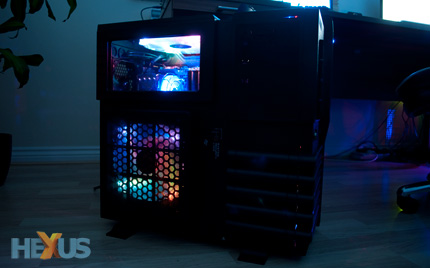Hot or not?
With the chassis geared up and looking menacing, we set out to test its cooling capabilities by pitting it against a similarly-priced high-end alternative - Corsair's Obsidian Series 800D.
Here are the pertinent specifications of both chassis, as well as a break down of our system configuration:
Comparison Chassis |
||
|---|---|---|
| Thermaltake Level 10 GT | Corsair Obsidian Series 800D | |
| Case type | Full-tower | Full-tower |
| Dimensions (W x H x D) | 282mm x 584mm x 590mm | 229mm x 609mm x 609mm |
| Weight | 12.7kg | 10.2kg |
| Available colour | Black with red highlights | Matte black |
| Material | Steel and plastic | Aluminium faceplate and steel structure |
| Motherboard support | mATX, ATX, eATX | mATX, ATX, eATX |
| 5.25in drive bays | 4 | 5 |
| 3.5in external drive bays | 5 hot-swappable 1 exposed |
4 hot-swappable 2 internal |
| I/O panel | USB 3.0 x2 USB 2.0 x4 Mic x 1 Audio x 1 eSATA x1 |
USB 2.0 x4 Audio x1 Mic x1 FireWire x1 |
| Expansion slots | 8 | 7 |
| Supplied fans | Front intake: 200mm colorshift fan (600-800RPM, 13-15dBA) Rear exhaust: 140mm turbo fan (1,000RPM, 16dBA) Top exhaust: 200mm colorshift fan (600-800RPM, 13-15dBA) Side intake: 200mm colorshift fan (600-800RPM, 13-15dBA) |
1 x 140mm fan (drive-bay) 1 x 140mm fan (lower compartment) 1 x 140mm fan (exhaust) |
| Power supply | ATX (not supplied) | ATX (not supplied) |
| Price | $259.99 / £* | $269.99 / £229.99 |
| *UK pricing to be confirmed | ||
System Configuration |
||
|---|---|---|
| Motherboard | ASUS P6X58D Premium | |
| CPU | Intel Core i7 980X Extreme Edition (with reference cooler) | |
| Memory | 6GB (3 x 2GB) Corsair Dominator DDR3 | |
| Graphics card | AMD Radeon HD 6970 | |
| Power supply | Corsair HX1000W | |
| Hard drives | Corsair Force Series F80 SSD | |
To measure CPU cooling performance, we set fan speed to standard and record CPU temperature when the system is idle. We then apply a 15-minute load of the Prime95 stress test and record CPU temperature again. To demonstrate the chassis' optimum cooling capability, we then set all fans - including the CPU cooler - to high speed mode and re-run the Prime95 torture test for a further 15 minutes.
Similarly, GPU temperature is recorded in three states; idle, load with fans at standard speed and load with fans at high speed. In this test, GPU load is defined as a 15-minute stint of Furmark.
Both chassis are tested only with the standard manufacturer-supplied fans, but readers should note that ambient temperature during testing does vary. Benchmarks on the Corsair Obsidian Series 800D were conducted with an ambient temperature of 18.3ºC, while the Thermaltake Level 10 GT was tested in a fractionally warmer 18.9ºC environment.

There's very little to separate the two high-end chassis at standard fan speeds. Given the slightly higher ambient temperature, Thermaltake's Level 10 GT does well to match the Corsair 800D and manages to pull out a lead of 2ºC with the fans running at full tilt.

There's a clearer gap when it comes to GPU cooling. Thermaltake's 200mm side intake proves its worth and at full speed it's able to lower the temperature of our Radeon HD 6970 GPU by 4-5ºC. The signs are good for anyone eyeing up a hot-running multi-GPU configuration.










